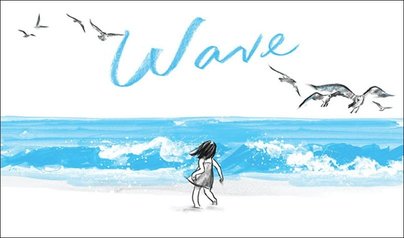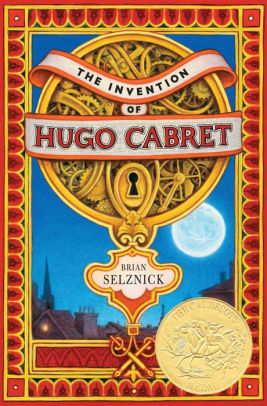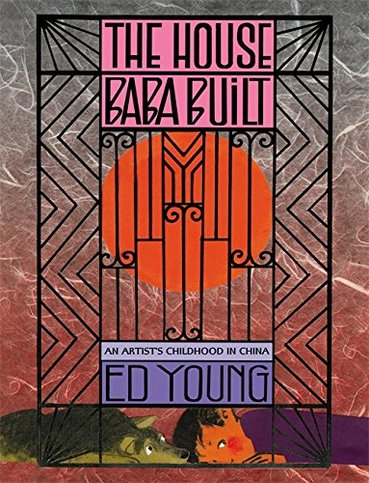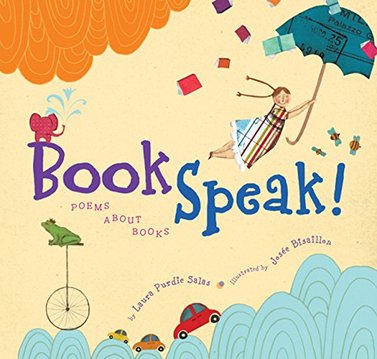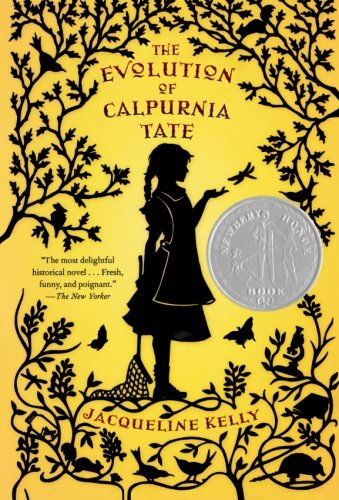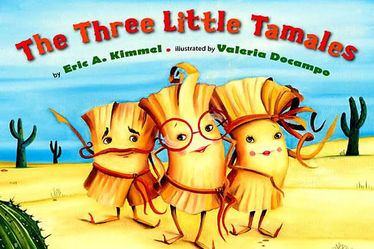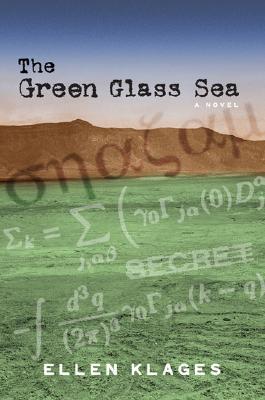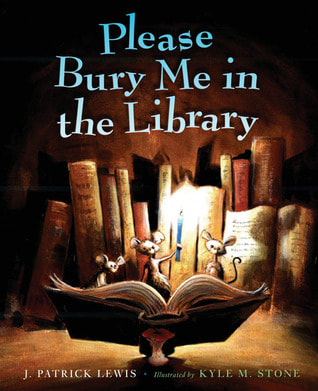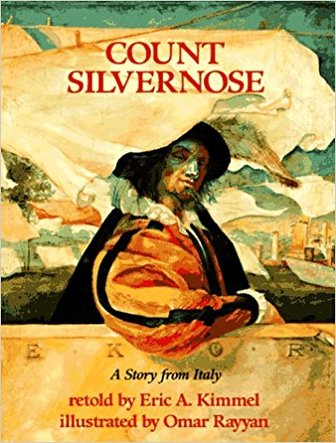|
Lee, Suzy. Wave. San Francisco: Chronicle Books, 2008. Wave presents a stunning visual narrative in charcoal and acrylics; the illustrations, which are primarily gray-scale, with the exception of the sea-blue waves, create a beautiful contrast that focuses on the majesty of the ocean. The story follows a young girl, whose relationship with the waves is tentative at first, but she eventually embraces the water and gifts presented by the beach. The most exquisite part of this picture book, aside from the art, is that the lack of text allows the reader to create his or her own narration. When my daughter was younger, 2-3 years old, I would narrate the illustrations for her; however, I was still able to ask her questions about how the girl or the waves were behaving, and she could give me accurate answers based solely on the art. Now that she’s 4, almost 5, she narrates the story herself. I love that she is able to develop her own creativity and story-telling skills with Lee's captivating illustrations to facilitate. This is a fantastic book to teach visual literacy, creative writing, and art appreciation. This is a great addition for your child’s library, as it allows for parents and children to bond over the narrative. Suzy Lee's art and your imagination make for an aesthetic trip to the beach.
0 Comments
Selznick, Brian. The Invention of Hugo Cabret. New York: Scholastic Press, 2007.
The Invention of Hugo Cabret follows a young, orphaned boy, Hugo, who lives in the train station and secretively maintains the station's clocks. Hugo's only company is a broken automaton, which he rescued from a burned down museum, and plans to fix, paying homage to his father's life and work. However, when an old man catches Hugo stealing from his toy shop, Hugo's mysterious journey begins. Hugo befriends the old man's goddaughter, Isabelle, who helps him discover that Hugo's and the old man's lives are inexplicably linked through imagination and dreams. The Invention of Hugo Cabret is a beautiful piece of literature that embodies the whimsy illustrated through its pages; it proves that, like film, literature is magical. Brian Selznick created an exciting, moving, and timeless story that exhibits the power of the imagination, which transcends generations. Selznick's characters embody an individuality and quirkiness; Hugo, Isabelle, and Papa Georges view the world in a transcendent glow characteristic of childhood perception, which appeals to children and adults alike. Hugo's enigmatic automaton and Papa Georges's secret past lure the reader into the world of the novel. Thematically, The Invention of Hugo Cabret utilizes the metaphor of clocks to represent how people, like machines, "are made for some reason," highlighting that both broken machines and people may be repaired (374). In addition to the assertion that all people have a purpose in life, Selznick extols the power of the imagination, creativity, and art. In reference to Papa Georges, he writes, "he was among the first to demonstrate that film didn't have to reflect real life. He quickly realized that film had the power to capture dreams" (355). Selznick's novel exemplifies the ways in which art can capture dreams, while also providing insightful commentary about the workings of real life. Furthermore, the black and white illustrations in Brian Selznick's work are enchanting, and they perfectly complement the themes and plot of his story. He incorporates cinematic elements, which mirrors the emphasis placed on film in his tale, into his drawings. For example, the book opens with a small drawing of the moon, which, page by page, becomes larger and gradually encompasses the city of Paris, eventually focusing in on the train station, and then a close-up of Hugo. The drawings scan the setting, moving the reader about the scene, just as a camera would. Adding to the fantasy, film stills and photographs are included to exhibit the magic of film in real life. Reviews: Starred review in Booklist – “The 2008 Caldecott Medal winner and a 2008 Notable Children’s Book.” "The Invention Of Hugo Cabret." Kirkus Reviews75.22 (2007): 20. Library, Information Science & Technology Abstracts with Full Text. Web. 30 Jan. 2013. - Selznick’s art blends “with period photographs to create a complex and satisfying story and visual experience.” R., S. "The Invention Of Hugo Cabret." Horn Book Magazine 83.2 (2007): 173-175. Library, Information Science & Technology Abstracts with Full Text. Web. 30 Jan. 2013. “The interplay between the illustrations and text is complete genius.” Connections: The Invention of Hugo Cabret would be a great way to lead a discussion on film as text, as well as turning text into film. Martin Scorsese directed a film version of "Hugo." Young, Ed. The House Baba Built: An Artist's Childhood in China. New York: Little, Brown and Company, 2011.
Ed Young, illustrator, author, and artist, wrote his autobiographical tale The House Baba Built as an account of his childhood in China during World War II. He recounts the ways in which he and his family grew closer in the house that his father designed to keep them safe from the war. The imagination and architecture within this nonfiction book entwine to pull the reader into a whimsical depiction of Young’s youth. Young’s story is deeply personal, but its sincerity reaches the reader, despite his/her being removed from the story’s specific setting. The heartfelt nature of The House Baba Built adds to the sense of its accuracy. Young includes a foreword, setting the historical climate, and an afterword, reflecting on the structure of Baba’s house. Additionally, he includes a timeline of important events in his family, family photos, and an author’s note, which relates his desire to accurately portray his childhood experiences. As the book moves chronologically through the time his family spent in the house that his father designed, the art and text captivate the reader with their lively and interconnected images. The figurative language, which permeates the text, is poignant and complements the striking array of visuals, which are comprised of a variety of mediums, including collage, pastels, charcoal, and photography. For example, the opening lines state that the “war was spreading to Shanghai, my father said, like the crows that came in summer and covered the sky with blackness” (1). The pages below the text present an ominous background blackened by crows with the outline of his family in red, like jubilant, red neon shining against a black sky, illustrating the contrast between his familial and governmental environments. Additionally, Young’s passion is evoked in the fold out pages and vivid, lively depictions of his imagination. One of the most fantastical visuals is the collage of ocean, pirate ship, and mermaids. The content is that of a childhood fantasy and immediately pleases the eye as well as heart. Reviews: Northrup, Mary. "The House Baba Built: An Artist's Childhood In China." Library Media Connection 30.5 (2012): 57.Library, Information Science & Technology Abstracts with Full Text. Web. 27 Mar. 2013. "The multimedia illustrations include clever collages of cutout shapes, torn paper, and photographs. An excellent example of a picture book for older readers, this book provides a good introduction to China during the World War II era." "CHILDREN's BOOKS: Nonfiction." Publishers Weekly 258.45 (2011): 44. Library, Information Science & Technology Abstracts with Full Text. Web. 27 Mar. 2013. "Caldecott Medalist Young shares a remarkable chapter of his family's history in this picture book memoir about his upbringing during WWII in a sprawling house in Shanghai built by his father." Starred book review in Booklist. Connections: This could be used in a multicultural studies unit with books about other cultures during WWII. This could be read with other books about WWII, such as Night. Ed Young's other books, such as Lon Po Po, could be read in conjunction with this one. Salas, Laura Purdie. BookSpeak!: Poems About Books. Illus. Josée Bisaillon. New York: Clarion Books, 2011.
BookSpeak! also presents a topical collection of poems about books. Each poem relates to readers, literary elements, writing, or book elements. Salas’s poems also reveal a variety of styles, including acrostic poems and free verse. Salas’s poems include a plethora of poetic and literary elements. She uses rhythm adeptly to create a spirited tone. In the opening poem, “Calling All Readers,” she incorporates rhyme, repetition, and appeals to the audience in order to create an anthem, inviting the audience to read. The rhythms and rhymes consistently create a jubilant tone, reiterating the entertaining nature of literature. In “A Character Pleads for His Life,” a nameless character pleads, “if you don’t help me, I will not survive/Only your actions can keep me alive,” imploring readers to liberate the characters trapped inside books. Additionally, Salas formats her poems to reflect their content. For example, in “On the Shelf and Under the Bed,” the used, bent, and read books are represented through free verse, symbolizing the liberated nature or their consumption. On the other hand, “Index” is much more structured, reflecting the strict configuration of an index. Overall, the poems are fanciful and endorse the jubilant, charming nature of books. Her poems, for the most part, were artistic and moving; yet, “The Middle’s Lament: A Poem for Three Voices” was trite and convoluted. Despite this, it is a beautiful collection of poetry and will inspire others to enjoy the world of literature. Josée Bisaillon illustrated BookSpeak! with a combination of drawing and collage. The art and poetry, in this case, are entwined and rely on one another. For example, “Skywriting” portrays black ink splotches, which turn into birds on a wire, as the poem describes words of a book as black birds against a white sky. Furthermore, the art itself is poetic. “If a Tree Falls” compares unopened books to birds trapped in a cage, and Bisaillon poignantly depicts a cage with some of the birds consisting of pages from books. Also, every poem is accompanied by an illustration, so that every poem has a visual partner. As far as formatting, Salas also played a part in the visual nature of her book by manipulating her text. For example, in “Cliffhanger” the last line of the poem tapers off as if falling from a cliff. Salas and Bisaillon’s collaboration concluded in a well-rounded anthology of poetry and art. Reviews: Cardon, Donna. "Bookspeak!: Poems About Books." School Library Journal 57.12 (2011): 104-105. Library, Information Science & Technology Abstracts with Full Text. Web. 27 Feb. 2013. "The poems are, by turns, philosophical, humorous, and even instructional. Typeset is creative, and the titles appear in a variety of artistic font styles and colors. Whimsical, mixed-media illustrations grace every page. Bisaillon skillfully incorporates the printed poems into the artwork so that the words and images have a single, unified, visual effect. This is an appealing offering that will be especially popular with librarians." "Bookspeak! Poems About Books." Publishers Weekly 258.42 (2011): 67. Library, Information Science & Technology Abstracts with Full Text. Web. 27 Feb. 2013. " From the outset, this collection of poems makes its message clear: books arc where it's at. Salas's polished verse demonstrates a deep love for all aspects of books, from their content to their creators." Connections: This anthology could be read with other topical anthologies on similar or different topics. Students could create their own poems or anthologies about the importance of reading and books. Student could read Stampede!, another collection by Salas. Salas, Laura Purdie. BookSpeak!: Poems About Books. Illus. Josée Bisaillon. New York: Clarion Books, 2011.
BookSpeak! also presents a topical collection of poems about books. Each poem relates to readers, literary elements, writing, or book elements. Salas’s poems also reveal a variety of styles, including acrostic poems and free verse. Salas’s poems include a plethora of poetic and literary elements. She uses rhythm adeptly to create a spirited tone. In the opening poem, “Calling All Readers,” she incorporates rhyme, repetition, and appeals to the audience in order to create an anthem, inviting the audience to read. The rhythms and rhymes consistently create a jubilant tone, reiterating the entertaining nature of literature. In “A Character Pleads for His Life,” a nameless character pleads, “if you don’t help me, I will not survive/Only your actions can keep me alive,” imploring readers to liberate the characters trapped inside books. Additionally, Salas formats her poems to reflect their content. For example, in “On the Shelf and Under the Bed,” the used, bent, and read books are represented through free verse, symbolizing the liberated nature or their consumption. On the other hand, “Index” is much more structured, reflecting the strict configuration of an index. Overall, the poems are fanciful and endorse the jubilant, charming nature of books. Her poems, for the most part, were artistic and moving; yet, “The Middle’s Lament: A Poem for Three Voices” was trite and convoluted. Despite this, it is a beautiful collection of poetry and will inspire others to enjoy the world of literature. Josée Bisaillon illustrated BookSpeak! with a combination of drawing and collage. The art and poetry, in this case, are entwined and rely on one another. For example, “Skywriting” portrays black ink splotches, which turn into birds on a wire, as the poem describes words of a book as black birds against a white sky. Furthermore, the art itself is poetic. “If a Tree Falls” compares unopened books to birds trapped in a cage, and Bisaillon poignantly depicts a cage with some of the birds consisting of pages from books. Also, every poem is accompanied by an illustration, so that every poem has a visual partner. As far as formatting, Salas also played a part in the visual nature of her book by manipulating her text. For example, in “Cliffhanger” the last line of the poem tapers off as if falling from a cliff. Salas and Bisaillon’s collaboration concluded in a well-rounded anthology of poetry and art. Reviews: Cardon, Donna. "Bookspeak!: Poems About Books." School Library Journal 57.12 (2011): 104-105. Library, Information Science & Technology Abstracts with Full Text. Web. 27 Feb. 2013. "The poems are, by turns, philosophical, humorous, and even instructional. Typeset is creative, and the titles appear in a variety of artistic font styles and colors. Whimsical, mixed-media illustrations grace every page. Bisaillon skillfully incorporates the printed poems into the artwork so that the words and images have a single, unified, visual effect. This is an appealing offering that will be especially popular with librarians." "Bookspeak! Poems About Books." Publishers Weekly 258.42 (2011): 67. Library, Information Science & Technology Abstracts with Full Text. Web. 27 Feb. 2013. " From the outset, this collection of poems makes its message clear: books arc where it's at. Salas's polished verse demonstrates a deep love for all aspects of books, from their content to their creators." Connections: This anthology could be read with other topical anthologies on similar or different topics. Students could create their own poems or anthologies about the importance of reading and books. Student could read Stampede!, another collection by Salas. Kimmel, Eric A. The Three Little Tamales. Illus. Valeria Docampo. New York: Marshall Cavendish Children, 2009.
In The Three Little Tamales, Kimmel provides a southern retelling of The Three Little Pigs. However, instead of pigs, the reader follows three little tamales, which escape a taqueria to avoid being eaten. In the desert, they make individual homes and sleep peacefully, until a wolf comes to destroy their houses and make a meal of the tamales. In the end, the tamales triumph and celebrate with a party for themselves and other runaway tortillas. Kimmel's version stays true to the original storyline of The Three Little Pigs; it opens with "Once upon a time" and two of the tamales build houses easily collapsed by the wolf, while the third perseveres. However, in this case, the third and most intelligent tamale is female. Her flouncy skirt, rosy cheeks and pink lips signify her sex, as her glasses represent her smarts. Kimmel presents a strong, clever heroine, which teaches that women are as capable of wit as men. Additionally, this retelling is set in Texas and through its language it embodies the same Tex-Mex flavors as its characters. The story adeptly incorporates Spanish to introduce children to two languages; in most cases, the Spanish words are discernable through the analysis of context clues, which enables children to exercise their critical reading skills, but it also includes a glossary of terms at the opening. Lastly, Kimmel incorporates the singsong, poetic nature of oral storytelling in the tamales' dialogue with the wolf. For example, in response to the first tamale, "Senor Lobo answered/I'll huff and I'll puff/like a Texas tornado/and blow your casita/from here to Laredo!" (12). The rhyming is playful and could be easily remembered and repeated by readers or listeners, therefore making the tale interactive. In the end, The Three Little Tamales exhibits that shrewdness can overcome obstacles and that this moral transcends cultures. Valeria Docampo’s illustrations add color and zest to Kimmel’s adaptation. The colors reflect the bright, saturated hues, evident in the opening pages on Tio Jose and Tia Lupe’s taqueria, of Tex-Mex eateries. These colors are carried throughout the pages in the maize-colored desert and tamales, the azure night scenes, and emerald cacti, adding to the southwestern feel of the text. Additionally, the painterly brush strokes add to the liveliness and fiesta-esque nature of the story; so that, both story and art are lighthearted and amusing. Reviews: Markson, Teri. "The Three Little Tamales." School Library Journal 55.6 (2009): 92. Library, Information Science & Technology Abstracts with Full Text. Web. 13 Feb. 2013. "Kimmel has pulled the pork from "The Three Little Pigs," wrapped it in masa, and cooked up another traditional tale flavored with Southwestern spice." Yusko, Shauna. "The Three Little Tamales." Booklist 105.14 (2009): 68. Library, Information Science & Technology Abstracts with Full Text. Web. 13 Feb. 2013. "An excellent addition to collections of fairy-tale retellings." "The Three Little Tamales." Kirkus Reviews 77.3 (2009): 118. Library, Information Science & Technology Abstracts with Full Text. Web. 13 Feb. 2013. "Docampo's oils are filled with southwestern colors and details. Her tamales each have a stereotyped personality all its own: the mustachioed macho brother, the pretty but not-too-bright sister and the smart sister who wears glasses. A flavorful addition to the folktale shelf that begs to be shared with a group." Connections: Read various versions of The Three Little Pigs to investigate the different ways in which they have been portrayed. Read tales written from the villain's point of view. Have students write their own version of the story of The Three Little Pigs or have the write their own story from the perspective of the villain. Klages, Ellen. The Green Glass Sea. New York: Viking, 2006.
Klages, Ellen. Performed by Julie Dretzin. The Green Glass Sea. New York: Recorded Books, 2007. CD. Ellen Klages’s The Green Glass Sea is set in America during World War II and follows eleven-year-old Dewey Kerrigan on her trip from St. Louis, where her Nana has just suffered a stroke, to New Mexico, where her father is working on a top secret gadget that will end WWII for the army. Dewey, who is interested in constructing machines, befriends Suze Gordon, an art-lover, and they learn to help each other through the difficulties of living through a war. Dewey is intelligent, introverted, but the other girls at her school, who call her Screwey Dewey, shun her. Readers may be able to identify with being an outsider and trying to find one’s place in the social world. Despite the way others treat her, Dewey is secure in her identity and does not let others upset her. She is a strong, positive role model. On the other hand, Suze is more outgoing and longs to fit in with the other girls at school, who secretly call her a truck. Trying to find her place with the popular girls, Suze contributes to the insults inflicted on Dewey, until their lives are thrown together, and Suze realizes that Dewey is the real friend for which she has been searching. The clothing, language, and habits, such as smoking, elucidate the setting of the 1940s, and Klages does not stray from the tragedy that curses war time or the ominous and yet innovative intrigue of developing the atom bomb. World War II provides an appropriate backdrop for the pain and growth that Dewey must endure. It emphasizes the dualities of life and how they entwine – power and destruction, science and art, life and death. At the end of her novel, Klages provides a brief note about the historical accuracy of The Hill, and cites sources for readers to find additional information. Lastly, the audio recording of the novel provides a more dramatic experience; Dretzin’s reading captures the turmoil as well as the innocence of the characters within the story. It allows readers to close their eyes and picture the 1940s unfurling before them. Reviews: 2007 Scott O'Dell Award for Historical Fiction 2007 Judy Lopez Memorial Award for Children's Literature Starred Review in Publisher's Weekly "Details about the era-popular music, pastimes and products-add authenticity to the story as do brief appearances of some historic figures including Robert Oppenheimer....the author provides much insight into the controversies surrounding the making of the bomb and brings to life the tensions of war experienced by adults and children alike." Starred Review in The Horn Book Connections: Students may read other Ellen Klages novels, including the sequel to this one White Sands, Red Menace. This books would be great to read while studying World War II and the creation of the first nuclear bomb. Students could create collages, as Suze does, to depict the novel or the time period. Mora, Pat. Doña Flor: A Tall Tale About A Giant Woman With A Great Big Heart. Illus. Raul Colon. New York: Alfred A. Knopf, 2005.
Doña Flor relates the tale of a giant woman, who lives to take care of and protect her neighbors. When the village becomes frightened of a giant puma, she spends her time investigating the cat, ensuring her neighbors' happiness and safety. The book is set in the American Southwest and introduces children, not only to pieces of Hispanic culture, but also to Spanish. It teaches children the importance of helping and caring for others. Additionally, it shows children that things are not always what they seem; the puma everyone is scared of ends up being nothing more than a tiny puma growling through a log. Raul Colon's illustrations have a southwestern style and color palette. The drawing of the wind, in particular, is light, airy, and fanciful. In this case, the art augments the cultural representation of the work. Awards: Peters, John. "Five Mighty Women." Teacher Librarian 37.4 (2010): 18. Library, Information Science & Technology Abstracts with Full Text. Web. 30 Jan. 2013. "An original tale set in the American Southwest and features scratchboard pictures as big and gentle as their oversized subject." "Doña Flor: A Tall Tale About A Giant Lady With A Great Big Heart." School Library Journal 52.(2006): 42. Library, Information Science & Technology Abstracts with Full Text. Web. 30 Jan. 2013. "Winner of the 2006 Pura Belpré Illustrator Medal" "Dona Flor: A Tall Tale About A Giant Lady With A Great Big Heart." Library Media Connection 24.5 (2006): 58.Library, Information Science & Technology Abstracts with Full Text. Web. 30 Jan. 2013. "Most tall tales were written long ago and featured men as main characters. This book is an excellent exception." Connections: Students could utilize this book while studying the American Southwest. To extend reading, students could read other books, written by Pat Mora, as well as books that reveal similar cultural experiences. For example, Gerald McDermott's Coyote: A Trickster Tale from the American Southwest focuses on the same geographical region. Lewis, J. Patrick. Please Bury Me in the Library. Illus. Kyle M. Stone. Orlando: Gulliver Books, 2005.
J. Patrick Lewis’s Please Bury Me in the Library is a topical collection of poetry, centering on books and the libraries that house them. His collection provides a variety of poetic styles, including haikus, acrostic poems, and free verse. The rhythms of his poems are playful and complement the humorous, lighthearted nature of the content. For example, the opening poem “What If Books Had Different Names?” provokes laughter with such adapted titles as “Winnie-the-Pooh Pooh-Poohs/The Walrus and the Carp and Her… Or Mary Had a Little Clam,” which are amusing to adults as well as children. Lewis utilizes rhyme to create the rhythms and merriness of his poems; however, the rhymes do not feel forced but occur as needed. Lewis incorporates some sound techniques such as alliteration, for example “blinking back the/wee wonder,” but these devices are used with discretion and are not overpowering. Lewis’s use of figurative language evokes the sweet innocence of childhood. In his poem “Please Bury Me in the Library,” he exploits personification and word play; the “Kids’ books dance”, the “Dictionary dozes”, there are “long-stemmed proses”, and “Bookworms in [his] coffin” (12). As a collection, Please Bury Me in the Library creates fantastical and inventive imagery, such as letters swimming in “Eating Alphabet Soup” (8). Books are lauded as being worth dying with, and they surpass generations in “A Classic” (12-14). This anthology promotes reading, books, and the library by showing the pleasurable and amusing aspects of each entity. The reader feels captivated by the magic of books through the reading of this one. The design of Please Bury Me in the Library is as captivating as its poems. Each poem is accompanied by an illustration by Kyle M. Stone. In some cases, the poem resides on a blank page, facing an illustration, and in other cases, the poem exists within the art. Stone’s artwork is whimsical and complements Lewis’s poems perfectly. The first illustration, in particular, is captivating. The painterly fashion of the brushstrokes, and the juxtaposition of the white and pink lamb and the bright green eggs and blue wall are enchanting. In all cases, the colors are rich and the brushstrokes add a touch of liveliness to his art. The art is mesmerizing enough that it could stand on its own; the illustrations create their own quirky tales, augmenting Lewis’s poetry. Reviews: "Please Bury Me In The Library." Library Media Connection 24.4 (2006): 84. Library, Information Science & Technology Abstracts with Full Text. Web. 27 Feb. 2013. "Although this beautifully illustrated picture book of clever poems is primarily for young children, it will tickle the fancy of most book lovers." Lempke, Susan Dove. "Please Bury Me In The Library." Horn Book Magazine 81.4 (2005): 483. Library, Information Science & Technology Abstracts with Full Text. Web. 27 Feb. 2013. "Fifteen poems in many forms extol the wonders of reading, books, and words." "Please Bury Me In The Library." Kirkus Reviews 73.7 (2005): 420. Library, Information Science & Technology Abstracts with Full Text. Web. 27 Feb. 2013. "Finishing with 'Acknowledgements' to 'Shel and Jack and Myra Cohn,' plus other 'word wizards,' this offering from the prolific Lewis won't stay buried long, no matter where it's planted." Connections: This collection could be read in conjunction with other topical anthologies on the same subject, such as BookSpeak! Students could create their own topical anthologies on a subject of their choosing. Students could write their own poem that could fit within the context of this book. Kimmel, Eric A. Count Silvernose. Illus. Omar Rayyan. New York: Holiday House, 1996.
Count Silvernose is based on an Italian folktale, which involves three sisters and a sly hobgoblin, posing as a rich count. The two beautiful sisters are led astray by Count Silvernose; however, the third, homely but astute, sister saves her siblings from an eternal, fiery pit. The tale concludes with the three sisters reunited and Count Silvernose left to a fate he had reserved for others. Kimmel begins his story classically with “Once upon a time;” yet, instead of romanticizing beautiful but helpless women, his tale critiques the “empty-headed” beauties and praises the “cleverness” of the sister “as ugly as a barn door.” This teaches that true heroines are those with sagacity, and anyone, regardless of beauty, can be a hero if they are perceptive and thoughtful. This tale also warns readers about avoiding temptation and encourages a prudent skepticism. The two beautiful sisters are easily beguiled by the count’s promises and appearance, regardless of having just met him. Children should learn to be cautious and become acquainted with someone before judging them. Despite these more modern feminist ideologies, Kimmel still incorporates the traditional motif of the supernatural with goblins and imps representing the danger and deceit in the world. The magical elements make the story more whimsical and endearing. Furthermore, the formatting of Kimmel’s text, especially on the pages in which the two beautiful sisters ride off with the count, is enchanting. The tapering off of the language mirrors the sisters and count “[riding] out of sight,” emphasizing the forethought and purposeful nature of Kimmel’s adaptation. The illustrations by Omar Rayyan evoke the Italian Renaissance perfectly. The pages imitate yellowed and worn journal pages, and the sketched figures and landscapes, some delicately painted, mimic Leonardo da Vinci’s drawings. Likewise, the first image of the three sisters is formatted in the traditional, Renaissance pyramid layout, with the middle sister’s head forming the apex. The traditional appearance of the art does not come without humor. On the first page, the obviously unattractive sister, appears to have a lazy eye, is postured like a man, and appears to be grimacing. Furthermore, at one point, the mother parodies Edvard Munch’s The Scream but with bulging eyeballs. Lastly, one of the most bewitching paintings is that of Assunta battling the imps and goblins. Rayyan captures the fairy-tale element of these creatures, which ties in seamlessly with the traditional Italian folktale aspect of the book. Reviews: E.S.W. "Count Silvernose." Horn Book Magazine 72.4 (1996): 471. Library, Information Science & Technology Abstracts with Full Text. Web. 13 Feb. 2013. "Occasionally threatening to burst out of control, Rayyan's dramatic illustrations are generally well suited to the robust tale." Starred book review in Booklist. Scanlon, Donna L. "Book Review: Preschool & Primary Grades." School Library Journal 42.3 (1996): 189. Library, Information Science & Technology Abstracts with Full Text. Web. 13 Feb. 2013. "The illustrations and narrative balance one another beautifully." Connections: Students may read other Italian folktales or other versions of Count Silvernose and compare and contrast the textual and artistic elements. Students could also compare and contrast other countries' folktales with this one. |
|
